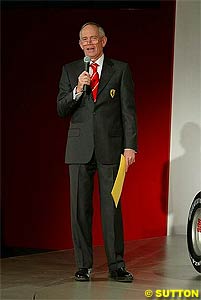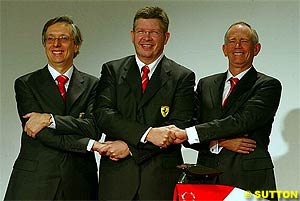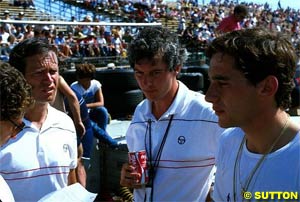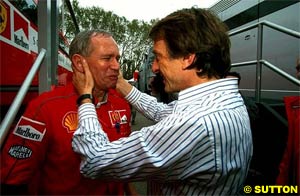
Atlas F1 Magazine Writer
From a slow start at the beginning of his career, most people now assume that any car designed by Rory Byrne will automatically win both Championships. Fellow South African Dieter Rencken looks at the reasons why everything the man touches turns, seemingly, to gold
Well, the chances are that an Industrial Chemistry degree will win your cars 12 World Championships in ten years. Incredible as it may sound that summates Rory Byrne's CV, the man whose designs have won every Championship going since 2000 and more than a few before that.
On a team front Benetton won 27 Grands Prix, via Gerhard Berger, Nelson Piquet, Schumacher and Johnny Herbert, during its illustrious life; only its swansong Grand Prix victory (the 1997 German, again with Berger), was not courtesy of Byrne.
Born in Pretoria, South Africa 60 years ago last week, Rory's primary competitive interest was hand-launched model gliders. He built his own and entered competitions. By age 16 he and brother Gavin, now a civil engineer in Johannesburg, were world champions in their class!
Industrial chemistry at Johannesburg's Witswatersrand University followed, but the automotive bug had bitten and, although Byrne completed his bachelor's degree in the subject, studies and racing cars were uneasy bedfellows. He modified Ford Anglias for saloon racing, acquired an interest in a 'speed shop', and eventually designed and built a moderately successful Formula Ford racer, the Fulman, for Roy Klomfass.
When the driver decided to further his career in the United Kingdom in 1974, he invited newly-graduated Byrne - the son of Irish parents, which eliminated the work permit problems experienced by all South Africans in those apartheid days - to join him. Klomfass settled on a Royale chassis, and the chemist set about concocting ever-faster formulae for the Ford.
The Royale team appointed him Technical Director and his RP21s and 25s swept all before them. But times were hard: "At one stage we lived in a bus, parked in a cul-de-sac down a friend's street. In winter…" admits a laughing Byrne now, whose present living standards in Maranello (and Thailand, from where wife Pornthip hails) are a far cry from that red double-decker.
Ted Toleman, a racing nut if ever there was one, agreed to the deal - despite Dougall breaking both legs in a cart-wheeling crash at Oulton Park the very day the decision was taken "after a guy who should have known better got stupid and crashed, taking me with him in a big way" - and Byrne was on his way to F1, for that is where the swashbuckling Toleman's ultimate ambitions lay.
Toleman increased his backing for 1977 and Dougall and Byrne contested (and dominated) both British Formula Ford 2000 Championships (for wings and slicks cars). The following year the trio went to European Formula Two and, again, victory followed. Toleman looked to building his own cars, and who else would he choose but Byrne to engineer them? The outfit - sans Dougall, whose SA connections were too close for comfort for main sponsor BP - won the 1980 F2 Championship.
BP, of course, continued to trade in South Africa, though.
Following Renault's 1977 lead, Formula One had by then embraced the turbo concept vigorously - with BMW and Honda converting Formula Two engines to F1 spec by the simple expedient of adding a blower or two. Surely Toleman's engine supplier Brian Hart could be persuaded to do the same?
Of course, at the time, Byrne was up against another South African designer - Gordon Murray, whose Brabham BT49 was walking the 1981 Championship, and would take the 1983 equivalent - and little did they know that one day their brainchildren would dominate 'most successful design' arguments; Gordon with the McLaren MP4/4, Rory with Ferrari's F2002.
But that was aeons away, and Byrne and Toleman slogged through various drivers, including Ayrton Senna - who made his debut in TG 183 - four designs and two engine suppliers before Berger delivered the 1986 Mexican GP win after a strategically faultless drive. By then, though, the team had become Benetton after Toleman had been forced to give up the unequal struggle - particularly after both Goodyear and Pirelli declined to supply the team with tyres due to politics.
Difficult those early days may have been, but Rory's designs always bristled with remarkable aero solutions - even more remarkable given the designers lack of formal training in that field. It all harked back to those gliders, the craft being, as Rory once told me "all about maximum strength via minimum weight; maximum lift via minimum drag". Convert lift to downforce (for, in real terms, it is merely the inverse) and you have the fundamental requirements of a Formula One chassis - Byrne's undisputed area of expertise.
The less said about his quick detour to Reynard the better - the car eventually surfaced, five years later, as the first Pacific - but soon Rory was back to his winning ways with Benetton, who were about to sensationally snatch a certain young German away from a naïve Eddie Jordan. Exactly a year after Schumacher's 1991 debut at Spa in a 'winkle picker' Jordan 191 he won at the same circuit; the 1993 Portuguese was his next victory.
Rory's B195 brought his first Constructor's Championship (in addition to Michael's repeat), and that, thought Byrne, was it. Long a qualified ocean diver and instructor, he and Pornthip, whom he met in a Thai restaurant near Benetton's Oxfordshire base, identified a superb site on the coast of her home country at which to base a diving school.
He resigned from Benetton when it became evident that Michael was Maranello-bound, and headed east to establish the school. No sooner was he set up than his mobile phone rang in early 1997. It was Jean Todt: "Rory, Jean Todt here. Come to Ferrari. Only one man can give Michael a title-winning car - YOU." Thus the chemist swapped the gold beaches of Thailand for the cold of wintry Maranello, and set about the task of adapting John Barnard's 1997 car before planning for the first red Byrne car.
The rest is history. 1997 delivered five wins for Schumacher and Maranello - to equal Ferrari's combined 1991 - 1996 tally. 1998 brought six, whilst the following year should have seen the double but for Schumacher's leg-breaking shunt at Silverstone. Still, the car provided Byrne's second constructors' win.
From 2000 the field has not seen Ferrari for Bridgestone dust. Doubles every year, some of them record-breaking. Virtually every Michael win sets another record and with Todt, Ross Brawn, Byrne and Rubens Barrichello all confirmed at Maranello for another three straight seasons, there is no forecasting where and when the run will end.
The Concise Oxford Dictionary defines chemistry as the "the branch of science concerned with the properties and interactions of the substances of which matter is composed", whilst defining alchemy as "the forerunner of chemistry, concerned particularly with attempts to convert base metals into gold".
Considering the amount of gold Rory Byrne has brought Maranello, it's possible that he really studied industrial alchemy.
So you want to design Grand Prix cars? Do you study structural engineering (ala Colin Chapman), mechanical engineering (Patrick Head), aerodynamics (Adrian Newey/Mike Gascoyne) or computational fluid dynamics (Geoff Willis)?
 Put differently, every one bar three of Michael Schumacher's 70 Grand Prix wins (those of 1996) has been in a Rory Byrne-car; every one of his six Championships has been through the South African's design genius. Eddie Irvine got his big chance in a Byrne car, and Nelson Piquet successfully saw out his illustrious career in one. Johnny Herbert counts himself amongst multiple Grand Prix winners thanks to Rory, as does Rubens Barrichello.
Put differently, every one bar three of Michael Schumacher's 70 Grand Prix wins (those of 1996) has been in a Rory Byrne-car; every one of his six Championships has been through the South African's design genius. Eddie Irvine got his big chance in a Byrne car, and Nelson Piquet successfully saw out his illustrious career in one. Johnny Herbert counts himself amongst multiple Grand Prix winners thanks to Rory, as does Rubens Barrichello.
 Another South African, Rad Dougall, provided the next step. Dougall, a winner in South African Formula Vees and Fords, travelled to the UK, came third in the 1975 Formula Ford, and stayed on. (Scottish ancestry aided his cause…) Rad, running a Byrne-designed Royale in the British FFord Championships, put a proposal to the Toleman Group, then the largest car transporting operation in Europe, for backing to continue his 1976 season.
Another South African, Rad Dougall, provided the next step. Dougall, a winner in South African Formula Vees and Fords, travelled to the UK, came third in the 1975 Formula Ford, and stayed on. (Scottish ancestry aided his cause…) Rad, running a Byrne-designed Royale in the British FFord Championships, put a proposal to the Toleman Group, then the largest car transporting operation in Europe, for backing to continue his 1976 season.
 For a fee he could, and two of Rory's Toleman-Hart TG181s were entered for the 1981 San Marino Grand Prix. Drivers Brian Henton and Derek Warwick failed to qualify, as they did for the next eight Grands Prix. Eventually, on 13 September 1981 at Monza, a Rory Byrne design started a Formula One race - in the hands of Henton. Canada was next, and provided two DNQs, whilst the USA (Las Vegas) Grand Prix saw Warwick make his debut start.
For a fee he could, and two of Rory's Toleman-Hart TG181s were entered for the 1981 San Marino Grand Prix. Drivers Brian Henton and Derek Warwick failed to qualify, as they did for the next eight Grands Prix. Eventually, on 13 September 1981 at Monza, a Rory Byrne design started a Formula One race - in the hands of Henton. Canada was next, and provided two DNQs, whilst the USA (Las Vegas) Grand Prix saw Warwick make his debut start.
 Then came 1994, controversy, Senna's tragedy, Schumacher's disqualifications, and the world Driver's Championship. Ask Byrne about those dark days and he is adamant B194 car was totally legal, that hidden gizmos were just that: hidden, and not seen or used. Well, he would, wouldn't he? But, there is another side to it all, and that is that motor racing never keeps secrets very long. Yet, never has a single employee (on or off the record) provided any evidence that untoward systems were used at any stage. And, over the years, many Benetton staffers have moved on, not always in happy circumstances.
Then came 1994, controversy, Senna's tragedy, Schumacher's disqualifications, and the world Driver's Championship. Ask Byrne about those dark days and he is adamant B194 car was totally legal, that hidden gizmos were just that: hidden, and not seen or used. Well, he would, wouldn't he? But, there is another side to it all, and that is that motor racing never keeps secrets very long. Yet, never has a single employee (on or off the record) provided any evidence that untoward systems were used at any stage. And, over the years, many Benetton staffers have moved on, not always in happy circumstances.
Please Contact Us for permission to republish this or any other material from Atlas F1.
|
Volume 10, Issue 4
Articles
The Alchemist
Interview with Rubens Barrichello
Technical Analysis: Ferrari F2004
A Visit to the Cat-House
2004 Countdown: Facts & Stats
Columns
Rear View Mirror
Bookworm Critique
Elsewhere in Racing
> Homepage |